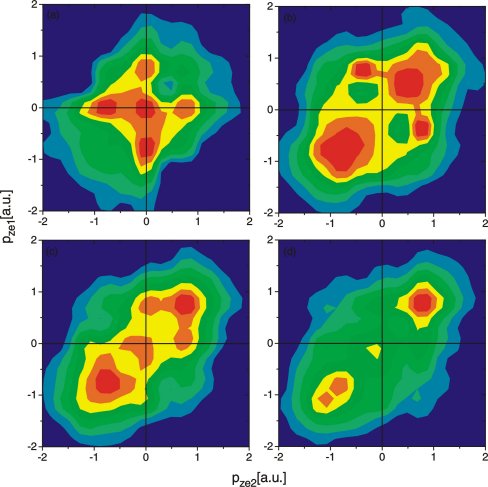Electron repulsion in nonsequential strong field double ionization
|
We have measured the coincident momenta of both electrons emitted in argon double ionization at 780 nm and 4.7*1014W/cm. For electrons which are emitted with very small momentum transverse to the electric field, we find that the two electrons have very unequal momentum. This is in contrast to the situation for larger transverse momenta for which most electrons are found with similar momentum. We interpret this observation as a manifestation of electron repulsion. We also identify contributions from electron impact excitation. The most likely scenario today for the correlation dynamics of electrons is given by the rescattering model (for further informations click here). The first experimental work observing the correlated momentum of the electrons (view the article: Nature 405, 658 - 661 (2000) as.ps(752kb) or as .zip(147kb)) showed a collective emission of both electrons to the same half sphere. Most likely the electrons were found having the same momentum component along the polarization axis. This is surprising since electron repulsion would push the electrons to opposite directions. In the strong field case the electron and ion final state momenta are influenced by electron repulsion and the action of the laser field on the charged particles. While the effect of the acceleration in the laser field is obvious in the coincident electron momenta (view the article: Nature 405, 658 - 661 (2000) as.ps(752kb) or as .zip(147kb)) surprisingly the influence of electron repulsion is not evident in any of the previous experiments. Here we succeeded in measuring the full momentum vector. The effect of the repulsion of the electrons becomes visible. The experiment was performed using COLTRIMS.  The laser pulse (150 fsec, 780nm) has been focused by a lens of 5 cm focal length into a supersonic Argon gas jet. The ions were guided by a weak electric field (3.5 V/cm) onto a position sensitive channel plate detector with delay-line readout. From the position of impact and the time-of-flight the three dimensional momentum vector can be determined. The electrons are guided by the electric field and a parallel magnetic field (10.4 Gauss) onto a second position sensitive detector. The electron momentum vector is determined from the time-of-flight and the position of impact. click on the image above to see an animation of the process (175kb).  One of the electrons has a transverse momentum of: (a) 0.0<p_perp<0.1 a.u. (b) 0.1<p_perp<0.2 a.u. (c) 0.2<p_perp<0.3 a.u. (d) 0.3<p_perp<0.4 a.u. The color coding shows the differential rate in arbitrary units. The vertical axis shows the momentum component of the one electron in the direction of polarization (pez1) and the horizontal axis the same momentum component of the other electron. For one of the electrons the transverse momentum has been fixed to a certain interval.
We observe a strong dependence of the correlation pattern on this transverse momentum.
If one electron is emitted off the polarization axis, then both
electrons are found to have most likely similar parallel momenta (figure d). In contrast
if one electron is fixed along the polarization with very small transverse moment (figure a), then we find mostly
one fast and one slow electron. 
Figure 2 The horizontal axis gives the phase of the laser field at the instant of recollision (a) return energy of the rescattered electron, (b) initial phase at which the electrons was set free. The arrows i and ii indicate the threshold for excitation and ionization, respectivly (c) electric field at return. The line indicate the critical field for over the barrier ionization of the first excited states (i) of Ar1+ In most cases excitation occurs at return phases where the field is high enough quench the excited state instantaniously. To discuss the measured distribution more quantitatively figure 3 shows the classically allowed region of phase space calculated within the rescattering model. We discuss the figure using the classical phase relations shown in figure 2. 
Figure 3 Classically allowed phase space within the rescattering model. The red area is for ionization the curved yellow line shows the locus of events for rescattering with excitation between the first excited state and the continuum, assuming instantanious quenching. The green area indicates the region of the most likely rescattering phase.
We point out that this curve in figure 2 relies on the fact that the
excited electron will be field ionized instantaneously. If this is the case depends
on the field at the return and thus also on the laser power and the atom under consideration.
The critical field for over the barrier ionization can be estimated to be 2.97*106 V/m for a binding energy of 11 eV
(first excited state of Ar1+).
|
